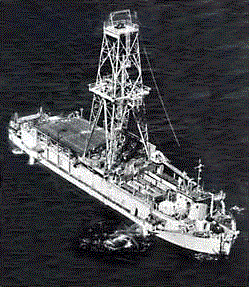
Back Mohole-projek Afrikaans Projekt Mohole Czech Project Mohole German Proyecto Mohole Spanish پروژه موهول Persian Mohole French פרויקט מוהול HE モホール計画 Japanese Project Mohole Dutch Mohole-prosjektet NN
 CUSS I | |
| Date | March–April 1961 |
|---|---|
| Location | Off Guadalupe Island, Mexico, Pacific Ocean |
| Participants | Willard Bascom, Walter Munk, Roger Revelle, John Steinbeck, William Riedel [d][1] |
| Outcome | First successful test of deep-ocean drilling techniques. |
Project Mohole was an attempt in the early 1960s to drill through the Earth's crust to obtain samples of the Mohorovičić discontinuity, or Moho, the boundary between the Earth's crust and mantle.[2] The project was intended to provide an earth science complement to the high-profile Space Race. While such a project was not feasible on land, drilling in the open ocean was more feasible, because the mantle lies much closer to the sea floor.[3]
Led by a group of scientists called the American Miscellaneous Society with funding from the National Science Foundation,[3] the project suffered from political and scientific opposition, mismanagement, and cost overruns. The U.S. House of Representatives defunded it in 1966.[4][5] By then a program of sediment drilling had branched from Project Mohole to become the Deep Sea Drilling Project of the National Science Foundation.[6]
- ^ "William Rex Riedel Biography" (PDF). Scripps Institution of Oceanography. Retrieved June 30, 2019.
- ^ The National Academy of Sciences. "Project Mohole, 1958–1966". Retrieved June 26, 2019.
- ^ a b von Storch, Hans; Klaus Hasselmann (2010). Seventy Years of Exploration in Oceanography: A Prolonged Weekend Discussion with Walter Munk. Berlin: Springer-Verlag. doi:10.1007/978-3-642-12087-9. ISBN 978-3-642-12086-2.
- ^ Mohole, LOCO, CORE, and JOIDES: A brief chronology Betty Shor, The Scripps Institution of Oceanography, August 1978, 7 pp. Retrieved June 25, 2019.
- ^ Sweeney, Daniel (1993). "Why Mohole was no hole". Invention and Technology Magazine – American Heritage. Vol. 9. pp. 55–63. Archived from the original on December 1, 2008. Retrieved August 14, 2011.
- ^ Winterer, Edward L. (2000). "Scientific Ocean Drilling, from AMSOC to COMPOST". 50 Years of Ocean Discovery: National Science Foundation 1950–2000. Washington, D.C.: National Academies Press (US).